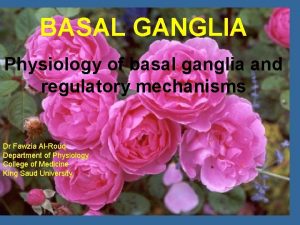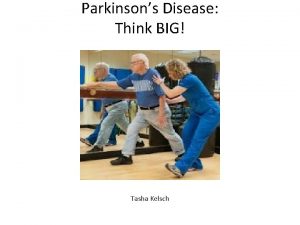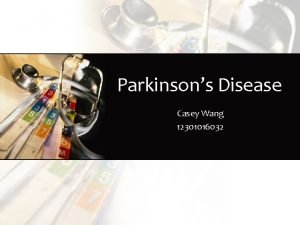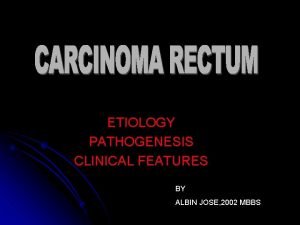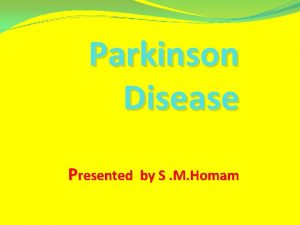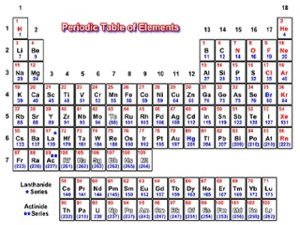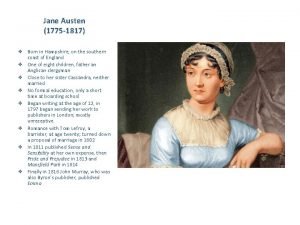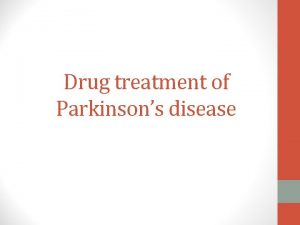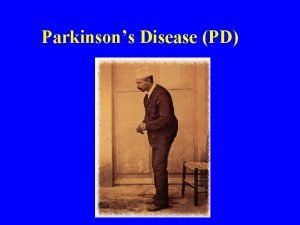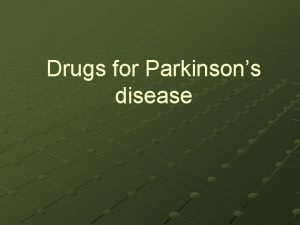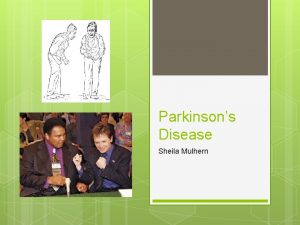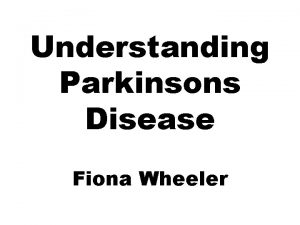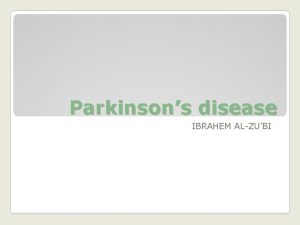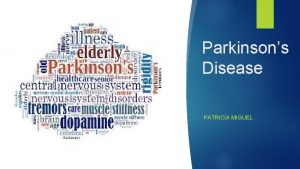Parkinsons Disease Casey Wang 12301016032 History In 1817















- Slides: 15

Parkinson’s Disease Casey Wang 12301016032

History • In 1817, James Parkinson published An Essay of the Shaking Palsy • Novel described six patients as having “Involuntary tremulous motion, with lessened muscular power, in parts not in action and even when supported; with a propensity to bend the trunk forwards, and to pass from a walking to a running pace: the senses and intellect being uninjured. ” • Parkinson’s Disease was known as paralysis agitans (shaking palsy in English), disease was later renamed by Jean-Marie Charcot

What is Parkinson’s Disease? • A progressive neurodegenerative disorder that affects movement • Develops gradually, sometimes beginning with a tremor in just one hand. Stiffness, or slowing of movement • Parkinson's disease can't be cured, medications may improve symptoms. In later stages, surgery to regulate certain regions of the brain may be suggested

Who is affected? • It is estimated that around 1 in 500 people are affected by Parkinson’s disease and there are currently 127, 000 people in the UK with the condition. • Average for symptoms to start is around 60; (1 in 20 cases first develop in people aged under 50) • Men are one-and-half times more likely to get Parkinson’s disease than women. • Caucasians are at a higher risk. Rates are significantly lower in African and Asian people.

Symptoms • Tremor. Shaking usually begins in the limbs. One characteristic of Parkinson's disease is tremor of your hand when it is relaxed (at rest). • Slowed movement (bradykinesia). Occurs overtime, steps may become shorter when you walk, or find it difficult to get out of a chair, feet may stick to the floor as you try to walk, making it difficult to move. • Speech changes. Speech is soft, quick, slurred, and will hesitate before talking. Monotone speech, without usual inflections • Loss of automatic movements. Decreased ability to perform unconscious movements, including blinking, smiling • Rigid muscles • Impaired posture and balance • Writing changes

Causes • Parkinson’s disease is caused by a loss of nerve cells in part of the substantia nigra, which leads to a reduction in the amount of a chemical called dopamine in the brain. • Dopamine plays a vital role in regulating the movement of the body and reduced dopamine level is responsible for many of the symptoms. • The cause behind loss of nerve cells is unclear. Most experts think it is due to a combination of genetic and environmental factors.

Changes in the Brain • The presence of Lewy bodies. Clumps of specific substances within brain cells are microscopic markers of PD. Researchers believe these Lewy bodies hold an important clue to the cause of Parkinson's disease. • Alpha-synuclein is found within Lewy bodies. An important natural and widespread protein among many. It's found in all Lewy bodies in a clumped form that cells can't break down.

Associated PD Genes • Alpha-synuclein (SNCA) – located on chromosome 4 is a specific gene that causes PD. Normally, the chromosome carries only a single copy of the alpha-synuclein gene – ‘Iowa kindred’ or ‘Spellman-Muenter kindred, ’ carried 3 copies of the gene. • Other mutated genes known to cause PD: parkin, leucine-rich repeat kinase 2, PTEN-induced putative kinase 1 • LRRK 2 — encodes for the protein, Dardarin — is only associated with PD. Mutations in the LRRK 2 gene that lead to PD are most common in people of North African, Basque, Portuguese – Some with LRRK 2 mutations develop PD in their 30 s-40 s, while others develop the disease in their 80 s, and others never develop PD at all. People with LRRK 2 gene mutations develop dementia, while others develop a form of Parkinson’s that shares features with amyotrophic lateral sclerosis (ALS)

Research • Mitochondrial dysfunction induced by knockdown of mortalin is rescued by Parkin • Animal Models: neurotoxin 6 -hydroxydopamine, also known as 6 OHDA, creates a model of Parkinson’s disease in rats by targeting and destroying dopaminergic neurons in the nigrostriatal pathway when injected into the substantia nigra • Neuroprotective treatments: A vaccine that primes the human immune system to destroy alpha-synuclein, PD 01 A (developed by Austrian company, Affiris), has entered clinical trials in humans


Treatment Medications: alleviate symptoms by increasing brain’s supply of dopamine • Carbidopa-levodopa (Parcopa). Levodopa, the most effective medication, is a natural chemical that is converted into dopamine. Levodopa is combined with carbidopa, which protects levodopa from premature conversion to dopamine outside your brain, prevents nausea. – Side effects: hallucinations, swelling, sleepiness, hypersexuality, gambling, and eating. • MAO B inhibitors. Metabolizes brain dopamine. Prevents breakdown dopamine by inhibiting the brain enzyme monoamine oxidase B (MAO B). • Catechol O-methyltransferase (COMT) inhibitors. mildly prolongs the effect of levodopa therapy by blocking an enzyme that breaks down levodopa • Deep brain stimulation. Electrodes are connected to a generator implanted in the chest that sends electrical pulses to the brain

Deep Brain Stimulation 1. A thin, insulated wire called a lead, or electrode that is placed into the brain 2. The neurostimulator, similar to a heart pacemaker, which is usually placed under the skin near the collarbone, but may be placed elsewhere in the body 3. Another thin, insulated wire called an extension that connects the lead to the neurostimulator

Because the cause of Parkinson's is unknown, definitive ways to prevent the disease also remain a mystery. However, some research has shown that caffeine — which is found in coffee, tea and cola — may reduce the risk of developing Parkinson's disease. Green tea also may reduce the risk of developing Parkinson's disease.

Muhammad Ali – diagnosed in 1984. (Head trauma, from activities such as boxing)

